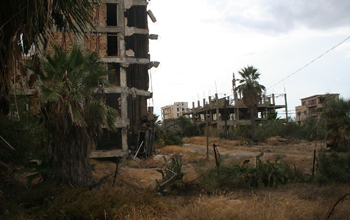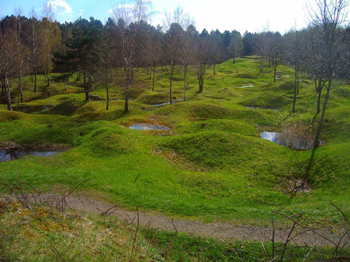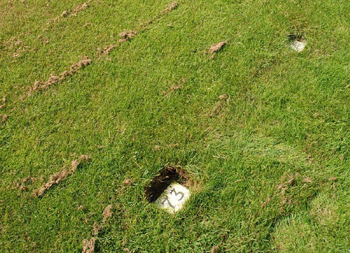6 Disturbing Abandoned Places (Hiding Right In Plain Sight)

Every place has awesome little secrets tucked away just out of sight of normal passersby, from the awe-inspiring view of the valley that tourists haven't yet ruined to the little taco cart that gives double helpings of guac if you ask while winking twice. However, there are some places off the beaten path that fully deserve to remain hidden in plain sight, for fear of stepping on a 70-year-old bomb or tripping over a mass grave. We're talking about ...
The Mass Grave Lingering Off NYC's Coast
Hart Island is a small piece of land between the Bronx and Long Island. Like most of the islands in that region, it was used for some shady-ass historical shit: a prisoner of war camp, a mental hospital, and a colony for tuberculosis sufferers. Those days are long past, however, and these days it's used for something a lot nicer. Yup, nowadays Hart Island is home to one of the largest mass graves in modern history.

There is no chance it isn't haunted.
If you suffer a fatal encounter with a New Yorker, as so many encounters with New Yorkers go, and your body goes unclaimed for several weeks, it'll eventually be shipped out to Hart Island for burial alongside the 900,000 homeless, unloved, and children already there. Yeah, we said children-- it's estimated that a third of the island's residents are children whose parents couldn't afford a funeral.

Turbo haunted.
That's what a potter's field is -- a place where people without the finances to afford a traditional burial are sent to be interred in anonymity by the state. There are no monuments, no headstones, and they only recently released a map showing the location of each mass grave. If you discover that you've got a relative resting on the island, you can only visit them for one day a month, an already-traumatic experience made worse by the fact that anyone visiting the island is treated like a criminal. And we mean that literally, because the island is run by the corrections department.

NO Bereaving
Why are correctional officers even running this show? Is there an imminent zombie crime spree that the media has failed to warn us about? Well, it's actually because the work of digging the graves and stacking the boxes -- 150 adults or 1,000 children to each pit, like the world's most depressing version of Lego -- falls to prisoners who are bused in every day to work for 50 cents an hour. You might find that horrifying, but there's an upside: After each grave is completed, the prisoners have a habit of making handmade crosses and leaving offerings of fruit/candy as an informal memorial to the buried.
Yeah, that's not really an upside. That's just depressing.
The Cyprus Tourist Resort Surrounded By Barbed Wire And Armed Guards
There's no less relaxing place to vacation than the Mediterranean resort of Varosha, Cyprus, where lounging on the beach requires liberal use of both sunscreen and a bulletproof vest.

These are not speedo conditions, is what we're saying
It wasn't always like this. In the 1970s, Varosha played host to the creme de la creme of high society, the resort's regular visitors including Richard Burton, Brigitte Bardot, and Elizabeth Taylor.

Happier, less perilous times.
What changed? Well, in 1974, Turkey invaded Cyprus, eventually coming to occupy a third of the island, including the now-abandoned Varosha. However, rather than call everyone back and fire up the margarita machines, the Turkish enclosed the resort in barbed wire, where it's remained to this day.

This will need more than a coat of paint to fix.
Turkey isn't being completely thick-headed about this. They recognized that the resort is valuable land, and assumed it would serve as a useful bargaining chip they could return to Cyprus in exchange for something else during the inevitable peace deal. A peace deal which has, decades later, never materialized, leaving the resort to rot in the meantime.
Although the perimeter is patrolled by armed guards with shoot-on-sight orders, urban explorers have managed to comb through what remains of the resort. Amongst the half collapsed buildings they've found car dealerships, fully stocked dress shops, and seafront stores taken over by turtles as nesting sites. It is unclear whether any of the turtles were married to Elizabeth Taylor.

So not as glamorous as old Hollywood, but at least someone's still getting some action here.
The Areas Of France Abandoned Because Of Unexploded Bombs
France has suffered the minor misfortune of being a central focus of not one but two world wars. As you might have guessed, this has had a few long-term consequences. World War I in particular, what with its titanic battles confined in narrow corridors, destroyed some regions so badly that they're still more or less uninhabitable to this day.

As with many maps, the red area is not good.
"Zone Rouge" is the name given to a chain of areas throughout Northeastern France where people are strictly forbidden from entering unless they're on official business or are looking to check "get obliterated by ancient ordinance" off of their bucket list. The environment within these areas is completely inhospitable to human life. The soil is contaminated with arsenic and chemical weapon residue. The ground is still littered with human and animal remains. And most worryingly, only a few inches into the soil, you can find unspent ammunition and grenades and unexploded artillery shells.

Those divots weren't caused by moles.
However, it's not exactly safe to go digging in the ground even outside of the red zone. Agriculture is a major industry in this area of France, and farmers have no choice but to regularly Hurt Locker their way through potentially explosive fields with their tractors to earn a living. This is known locally as the "Iron Harvest," because you've got to have a sense of humor about these things. When a farmer finds a shell, they can take it to a special dumping ground, where a team from the government's munitions disposal team will pick it up. It's estimated that 900 tons of munitions are disposed of in this way every year. And yes, people do die while doing it.
Disposing of 900 tons of bombs per year makes it seem like Zone Rouge should be cleared soon, right? Yeah, about that ... even with the old ordinance being removed at that rate, there are still thousands upon thousands more tons of century-old war murder hiding out there. The Iron Harvest isn't going to get any less butthole-puckering anytime soon.
The Dozens Of "Closed Cities" Scattered Across Russia
Russia probably has more than a few secrets tucked away in the far corners of its country-sized snowpile. Secrets have been their thing for a while now, and it seems a little late in the relationship to ask them to change their "bad boy" ways now. But we aren't talking about hidden bioweapon plants or rocket launchpads (although those certainly exist). No, we're talking about the dozens of full-scale cities hidden in plain sight, like massive needles in regular-sized haystacks.

They utterly dwarf the haystacks, in truth.
Officially known as "closed administrative territorial formations" by the government, these cities were originally built in secret to house workers employed at top-secret research and military facilities. After the fall of the USSR, funding for these cities plummeted, and a significant number were closed down.
But not all of them.
Although exact numbers are hard to come by, it's estimated that there are still more than 40 "closed cities" out there. And while the Soviet machine might have fallen, the country's recent financial upturn has meant an surge in funding and a corresponding return to the old ways. For instance, 10 of these cities are now under the control of Rosatom State Corporation, a fancy title for what used to be the Federal Agency for Atomic Energy. We'll leave it up to you to figure out what their main area of research is.

Got it on the first try.
So what's it like living in the oligarchical equivalent of The Truman Show? As one documentarian found out after they infiltrated the city of Ozersk, it's actually a pretty sweet deal for the people living there. Given the importance of the city to the government, its citizens have always been well taken care of, enjoying high-quality food, well-maintained housing, and low crime rates, even when the rest of the country was suffering. They were isolated from the rest of the country and their families, of course, but man, who doesn't want to get away from their relatives sometimes?
Oh, there is one other downside, at least in the case of Ozersk: the catastrophically high levels of radiation.

Our Russian isn't very good, but we think this is something about yielding. Or propellers.
The Military Cemetery With A Secret Plot For War Criminals
The Oise-Aisne American Cemetery in France is the final resting place of over 6,000 military personnel who perished during World War I. Ornately decorated, it stands as a monument commemorating the ultimate sacrifice that these men made in the name of freedom and justice.

It also commemorates top-notch landscaping.
However, the soldiers resting in the little-known area called "Plot E" don't get quite as much respect. If any monument had to be installed there, in fact, it'd be a ginormous middle finger flipping them off for all eternity. That's because Plot E is home to "the dishonourable dead" -- a group of soldiers who were executed for committing crimes like rape and murder. Although they were initially buried closer to their places of execution, all were moved to Plot E in 1949, as if someone flipped the switch on a shithead electromagnet.
Well, that's not entirely fair. One person was buried in Plot E for something that wasn't rape or murder: Eddie Slovik, a private who was executed in 1945 for desertion. Following an appeal to Ronald Reagan, Eddie's family successfully petitioned for his remains to be exhumed and re-interred closer to home, which also brought his nightmare afterlife roommate situation to a well-deserved close.
The plot is designed to be completely invisible to the outside world. It's not listed on maps, it's hidden by hedges, and the only access is through the superintendent's office. There aren't even any headstones; each grave is instead marked by a small plaque inscribed with a number corresponding to a special index.

Rest In Perfectly Indexed Peace.
Flags aren't permitted to be flown there, and the graves are even aligned in such a way that Plot E's occupants don't face the same way as the soldiers in Plots A-D. It's all very carefully considered, designed to communicate the dishonor without being cruel -- basically, how to be the biggest "Fuck you" without covering each grave in shit. The plots are meant to be forgotten, essentially, so it stands to reason that nobody is keeping real close track of that index.
The Jungle Which Stops The Pan-American Highway Stone Dead
If you're into crazy adventures and your absence from work could be disguised with a balloon on a stick, we'd recommend travelling the Pan-American Highway. It's a long and winding road that stretches the entire length of North and South America, from the furthest reaches of Alaska, through Denver and Mexico City, all the way down through Buenos Aires, terminating in the cold climes of Argentina. We don't want to sound too modest here, but it's hard not to take pride in our ability to tarmac anything that Mother Nature can throw at us. Well ... nearly everything. While the road from Alaska to Panama is unbroken, at one point, you will have to take a boat to Colombia if you want to continue onward, which (call us picky) technically ruins the whole "highway" image. The reason for this inconvenience is the Darien Gap, an impassable region of jungle, swamp, and pit vipers that is passive-aggressively -- and also active-aggressively -- resisting any attempt by civilization at being tamed.

But look! Free cars!
The Darien Gap has a long history of defeating travelers. Both the Spanish and the Scottish established trading posts here in the 15th and 16th centuries, only to suffer from a series of horrifying maladies for their efforts. The area has remained wild ever since. It wasn't until 1960 that someone managed to traverse the gap using a car -- a journey that took five months and averaged 200 meters a day, which is a speed more commonly known as "Let's give the fuck up and go back to the hotel."

This is one of the easier bits.
The only people to inhabit the Gap nowadays are indigenous tribes and drug traffickers, the latter group probably being responsible for the number of scientists and researchers who've gone missing there over the years. There are also the migrants from all over the world who pass through on their way to the United States.

The trip is incredibly dangerous, and also evidently preferable to what they were living in, which should tell us something.
Every once in a while, someone raises the idea of completing the Pan-American Highway. It's 2017; surely we must have mastered all the jungle-dominating technology that would require. The problem is that there are a few good cases for keeping the gap closed. For one, with no road cutting through it, the Darien Gap is relatively pristine, ecologically, so crushing it with bulldozers and asphalt would be like demolishing a wildlife preserve. Also, the lack of road impedes drug trafficking and the spread of certain diseases. And finally, given the Gap's history with people who have tried to conquer it, there's no guarantee any construction efforts wouldn't immediately awaken some vengeful plague or forest demon. So maybe keep taking the boat. Boats are good.
Check out Adam's new Facebook page! Or if you're, like, ancient, you can follow him on Twitter.
Also check out 5 Famous Cities With Creepy Secrets Hiding In Plain Sight and 5 Cool Secret Codes Hiding In Plain Sight Around The World.
Subscribe to our YouTube channel, and check out 7 Popular Restaurants With Secret Menu Items You Need To Try, and other videos you won't see on the site!
Follow us on Facebook, and let's be best friends forever.





